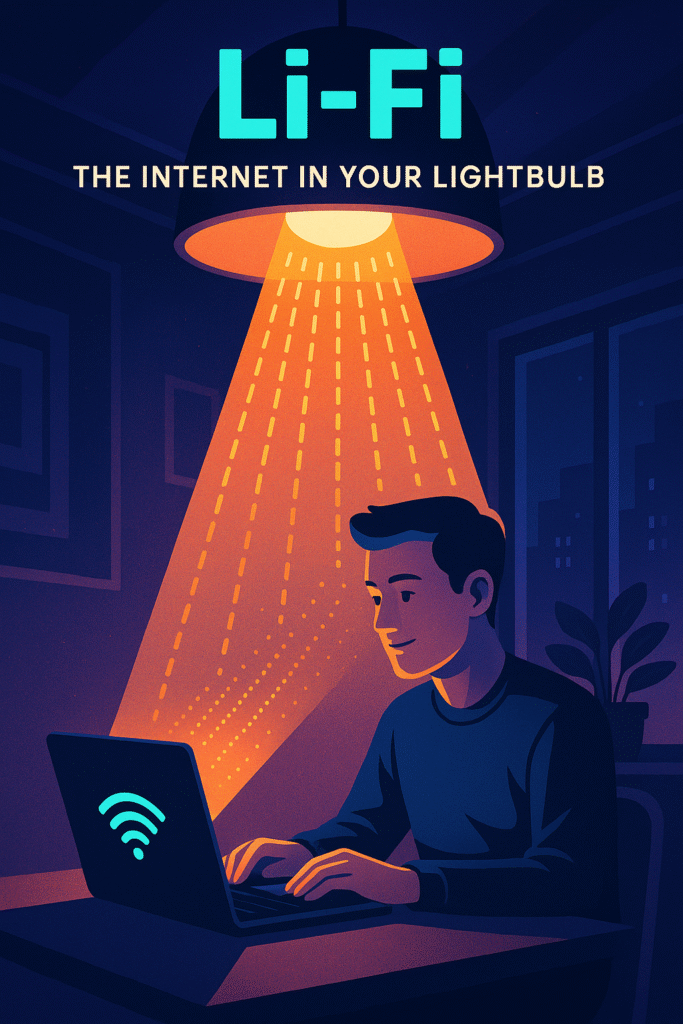
ChatGPT:
Li-Fi: Lighting the Way to the Future of Wireless Communication
We live in a world where our phones wake us up, connect us to music, news, friends, and even our work emails late at night. Wireless technology is everywhere. Yet, frustratingly, there are still places where Wi-Fi or mobile signals just don’t work—like deep underground, in thick-walled buildings, or secure zones where radio signals are banned.
This communication dead zone has led scientists to ask: what if we didn’t need radio waves at all? What if we could use light to beam data through the air?
Welcome to the world of Li-Fi, or “light fidelity,” a new wireless technology that uses invisible infrared light instead of traditional radio waves to transmit data. This essay explores how Li-Fi works, its advantages, and why it could become a major player in the future of connectivity.
🔍
Why Do We Need a New Wireless System?
- Dead zones still exist: Elevators, basements, tunnels, and remote areas often block traditional radio-based Wi-Fi or mobile signals.
- Overcrowded radio spectrum: The spectrum used for Wi-Fi and mobile communication is limited, and it’s getting increasingly crowded as demand for wireless data soars.
- Security concerns: Radio waves travel through walls, which makes Wi-Fi susceptible to eavesdropping and interference.
- Radio-free zones: Some places—like hospitals, airplanes, or government buildings—either limit or ban radio signals altogether due to safety or security concerns.
💡
What Is Li-Fi?
Li-Fi is a form of wireless communication that uses infrared or LED light to transmit data instead of microwaves or radio waves. It works by flickering light at extremely high speeds to encode digital information.
- Light = Data: Light bulbs are modulated (switched on and off) at speeds millions of times per second—too fast for the human eye to notice.
- Invisible flickers: Infrared LEDs can transmit data without any visible light, so the room stays dark or normally lit.
- Receiver required: A tiny photo-detector (a light sensor) picks up the flickering signals and decodes them back into usable data (like websites, emails, or videos).
🚀
How Li-Fi Works: A Step-by-Step Breakdown
- Light Source: A Li-Fi-enabled light (often an LED or infrared emitter) is placed in the room.
- Signal Modulation: The light is modulated to represent binary data (1s and 0s), flickering very rapidly.
- Transmission: The modulated light beam travels through open air.
- Receiver: A device with a light sensor (like a smartphone or laptop) receives the beam and decodes the data stream.
- Result: You get a wireless internet connection through light.
🌟
Advantages of Li-Fi Over Wi-Fi
✅
Vast Bandwidth Potential
- The visible and infrared light spectrum is thousands of times larger than the radio frequency (RF) spectrum.
- More bandwidth means faster speeds and better support for high data traffic.
✅
Fewer Interference Problems
- Unlike radio signals, light can be contained within a space and doesn’t interfere with other wireless systems.
- This means multiple Li-Fi systems can coexist in adjacent rooms or networks without signal clash.
✅
Enhanced Security
- Light doesn’t pass through walls, so data is confined to the lit area.
- Much harder for hackers to intercept, making Li-Fi ideal for high-security environments.
✅
Environmentally Friendly and Safe
- No electromagnetic interference: Perfect for hospitals, aircraft cabins, or sensitive industrial environments.
- Uses existing infrastructure: Light fixtures can be upgraded to Li-Fi transmitters with minimal modification.
🛠️
Real-World Applications and Developments
Li-Fi is no longer just a lab experiment—it’s already being used and tested in several industries:
🛡️
Military and Government Use
- Secure facilities that restrict radio waves are trialing Li-Fi for secure, room-contained communications.
- Its inability to leak outside walls is a natural defense against cyber-intrusion.
🛰️
Telecom and Internet Expansion
- Companies like pureLiFi have developed systems like Bridge XE, which can deliver gigabit internet to places where cables can’t go.
- This could revolutionize rural internet access, construction sites, and temporary disaster zones.
🏡
Smart Homes and Personal Devices
- Light sensors small enough to fit in phones, tablets, and wearables are being developed.
- Eventually, Li-Fi may work in tandem with Wi-Fi in homes, allowing for seamless, hybrid connectivity.
🧠
How Does Li-Fi Fit into the Bigger Picture?
Li-Fi isn’t meant to replace Wi-Fi completely—but it could become a complementary layer of connectivity:
- Imagine an office or classroom where Li-Fi is used for high-speed local data, while Wi-Fi or 5G handles general connectivity.
- Or homes where each room has smart lighting that also beams secure, fast internet to devices.
- In crowded areas like airports or stadiums, Li-Fi can reduce strain on Wi-Fi networks, providing backup lanes of data transmission.
🔐
Privacy by Design
Because Li-Fi is limited by the physical reach of light, it naturally:
- Prevents unintended access to your network.
- Limits interference between neighboring users.
- Offers the possibility of user-specific light zones, where only certain users/devices can receive a signal in a given space.
📈
What’s Next for Li-Fi?
Scientists and engineers continue to:
- Miniaturize components so Li-Fi receivers fit inside consumer devices.
- Improve speed and increase range by using more powerful infrared light.
- Develop standards for interoperability, ensuring Li-Fi works with existing internet protocols and devices.
Big electronics companies are exploring Li-Fi as the next innovation in connectivity, and several pilot programs are already underway in government, industrial, and telecom sectors.
✨
Conclusion: The Future Is Bright
In a world where internet access is essential yet patchy, Li-Fi offers a smart, secure, and elegant solution. By using light instead of radio waves, we unlock:
- Faster speeds
- Greater security
- Cleaner spectrum
- New frontiers for wireless communication
Instead of hunting for bars, we might soon look to the light overhead—where connectivity silently beams down with every flicker.
Li-Fi isn’t just the future. It’s already shining through.
